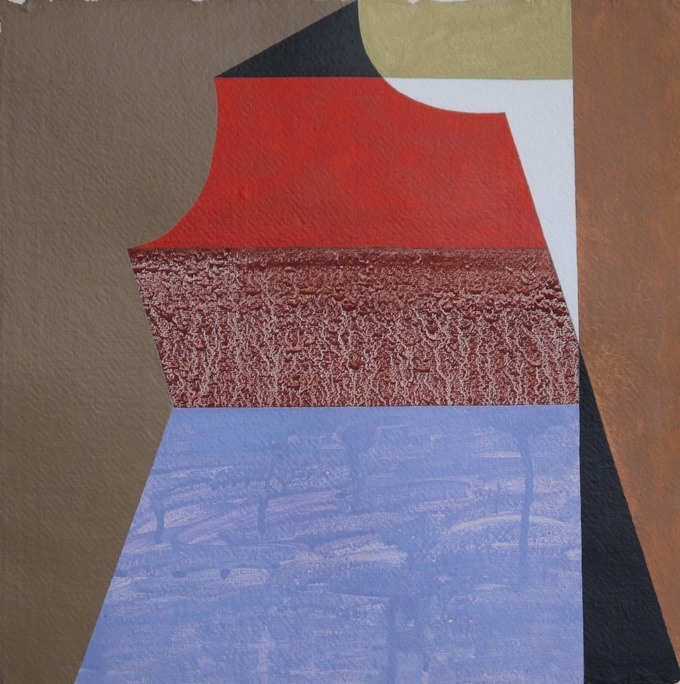Jim Grundy’s paintings are considered and incisive meditations on colour, shape and composition. In his carefully constructed pieces, he creates geometric abstract arrangements that comment on everything from nature and symmetry, to urban living and repetition. We sat down with Jim to find out more about his process, his inspiration and his unique artistic journey so far.
How would you describe what you create?
My aim is to create compelling works that draw the viewer in to explore the underlying structure. I hope that the initial reaction is an emotional response to the colour relationships, the contrasting textures between the flat and fluid paint and the hard edges and gestural marks. I want the viewer to be rewarded by further contemplation so that the placing of each element, the precise colour balance and carefully calibrated mathematical proportions are revealed. The inspiration comes from a wide range of sources, both natural and man-made but all share a preoccupation with pattern and structure.
What are the fundamental messages you want to get across with your work?
I think that harmony and balance can be achieved when reconciling very different and contrasting techniques and processes. For instance, there are sections where chance takes a prominent role as fluid paint is acted upon by gravity and flows down the surface showing a series of random events frozen in time. Areas of flat dense colour with very defined edges show a high degree of control. I see this as the human impact on the natural world, like human landscapes.
How did you come to geometric abstraction?
Patterns of all kinds fascinate me, including the hidden structures of living things. Tiling, repeat sequences, geometric shapes and grids, pre-historic symbols and pottery designs and the underlying laws that dictate how the natural world evolves. That all finds a way into my work which I don’t really consider to be pure geometric abstraction. Maybe hard edge is a better term as, looking back, I have always used very defined shapes but counterbalanced by gestural marks and the chance happenings that happen during the act of painting. My paintings are all inspired by something I have seen which has sparked my imagination. My paintings tend to have quite a long gestation period and I could come back to the source material years later and see a way to develop it.
Do specific colours and forms hold definite meanings in your work?
For me colour is the most important part of painting. The relationship between the size, shape and colour of each form to everything else in the composition goes through many permutations during the painting process. The dominance of each colour, the warmth or coolness, flatness or texture, as well as denseness and fluidity, are hopefully resolved so that there is a restless balance. The colours have symbolic meaning for me. The earth pigments are often mixed directly with medium to form the landscape where accidental meanderings and rivulets appear. I see this as a sedimentary evolutionary process, building up layers. The colours of sand, brick, plaster and other building materials reference the urban world. I see the contrasting lilac, purple and blue elements as more related to sky and water. The intense reds, yellows and pinks are more symbolic of the manufactured world around me.
Is there a significance in how you title your work?
I try to use terms that convey a range of meanings. For instance my "Figure" series has anatomical references but the word also brings to mind mathematical connections, as well as scientific diagrams. "Configuration" suggests an arrangement or composition as well as balance and the way a wide range of things including computers are put together. "Correspondence" brings to mind communication but also similarities between two elements and travel connections. The titles hopefully give a clue without being too descriptive, leaving the interpretation open to for each viewer to respond differently.
Have your reference points or goals of your work changed during your career?
I sometimes wonder how my 20-year-old self would respond to my more recent work. In many ways I can see similar preoccupations and themes running throughout my artistic journey. For instance, in the early 80s when I was just out of art school, I produced a series of works where the composition was created by marks dictated by the throw of dice. A random network of dashes across a grid was the starting point for each drawing where I responded with gestural marks. The aim was to create a balance between the two competing forces which remains a theme in my work.
What is the latest project you are working on?
Over the last year, I have been working on a series of paintings inspired by historic costume patterns. The diagrams intrigue me because they render the human figure as simplified cut-outs showing measurements and shapes. These are related to the human figure but are not descriptive and for me they become abstract compositions. They are not really figure paintings, but it is important to me that the human presence forms the underlying structure.

Jim Grundy experimenting with different sizes and textures to frame his piece, Figure No.17.
Name a formative experience you’ve had in the art world and what it taught you.
During my time working at the Tate Gallery, I was fortunate to collaborate with many inspirational artists and colleagues. As a manager and ultimately Head of the Art Handling department I was privileged to see iconic works at such an intimate level and contribute to the creation of some great exhibitions. Most memorable were the one to one periods with artists under the stress of a big occasion. They all handled fame, pressure and the competing demands on their time differently, but all were completely focused when it came to their art. It taught me that it is important to be disciplined with your time.







